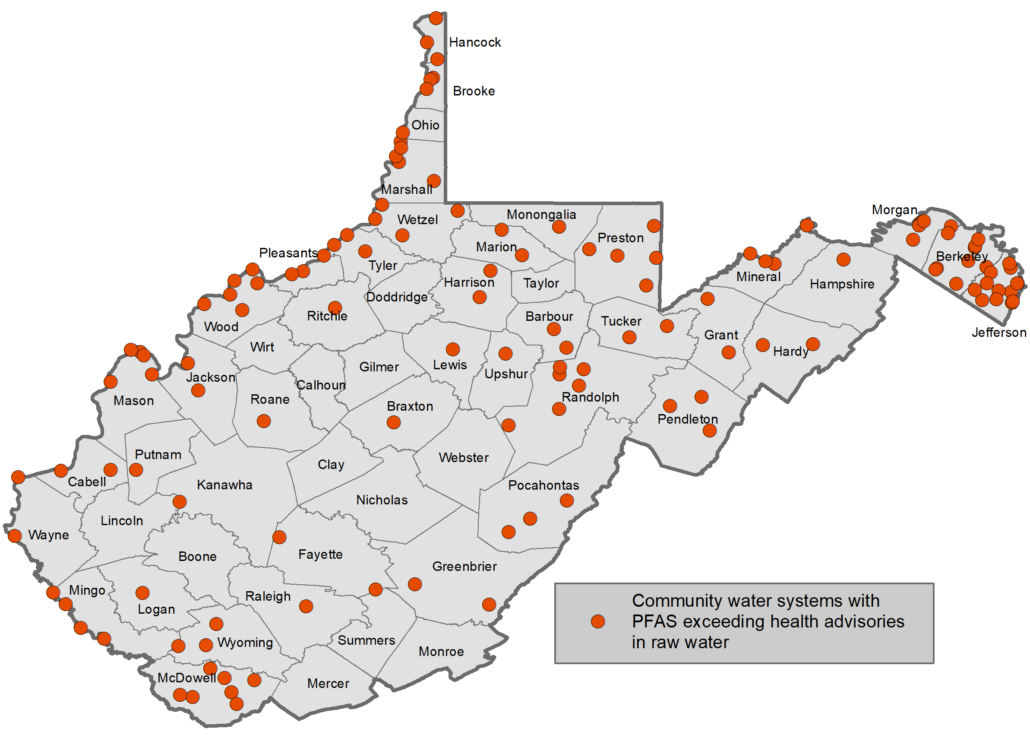Community Meetings on PFAS Action Plans Scheduled
Live in Northern WV or the Eastern Panhandle? Please attend our upcoming community meeting to discuss solutions for the PFAS problem. Everyone is welcome!
Virtual Community Meetings on PFAS Action Plans
Thursday, December 11, 2025
12-2 pm
Zoom – Register here
Contaminants have been detected in our drinking water
Man-made chemicals known as PFAS have been detected across West Virginia, including in public drinking water systems in Northern WV and the Eastern Panhandle. Affected communities include Follansbee, Chester, Weirton, Benwood, Berkeley Springs, Charles Town, Harpers Ferry, and Martinsburg. PFAS are used to create a wide range of waterproof, stain-resistant, and non-stick products. Many of these products are considered essential to modern life, public safety, and health. However, the same properties that make PFAS useful also make them extremely persistent in the environment.
You can find the water systems that showed elevated levels of PFAS in the statewide sampling of source water commissioned by DHHR and DEP, conducted by USGS in 2020, linked here.
PFAS and human health
Although PFAS have been manufactured and widely used since the 1950s, they remained undetected, unregulated, and largely unreported for decades. Today, PFAS are found in soil, air, water, and in the blood of nearly every human. Scientific research now shows that long-term exposure to certain PFAS may be linked to serious health risks, including cancer, liver damage, immune system harm, and developmental issues.
West Virginia’s response – The PFAS Protection Act
The West Virginia PFAS Protection Act outlines a strategy to
- Identify where PFAS is impacting public water systems,
- Determine which industries are using these chemicals, and
- Reduce the risks to people who rely on clean, accessible drinking water.
In response, the West Virginia Department of Environmental Protection (WVDEP) has conducted extensive sampling of drinking water across the state and is developing PFAS Action Plans for every affected public water system.
We need your help!
WVDEP is working in collaboration with the West Virginia Rivers Coalition, Fair Shake Environmental Legal Services, and other local organizations to host community meetings. These meetings will provide important information, offer opportunities to ask questions, and allow community members to share feedback.
Community knowledge plays a key role in developing effective and comprehensive action plans. Your input is critical, especially when it comes to identifying and mitigating potential sources of contamination.
All 2025 meetings have concluded. This page will be updated with future meeting times as they are scheduled.
Resources
PFAS 101: What You Need To Know. Learn about PFAS, how it gets into drinking water supplies, and what you can do.
PFAS Info Packet Data – Supplemental information on the community water systems with PFAS detections, information on number of people served by the system, and data on PFAS detection levels.
Study of PFAS in West Virginia’s pre-treated source water
Resources for Ohio River Valley Residents
In June of 2022, EPA released drinking water health advisories for four PFAS. These advisories indicate the levels above which these PFAS are dangerous to public health.
These maps depicts community water systems where PFAS were detected in raw water supplies exceeding current health advisories. Highest concentrations are found in the Eastern Panhandle and the Ohio River Valley. Double click the individual maps below to zoom in on geographic areas.



